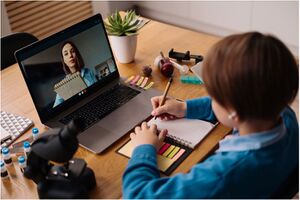How To Maintain Children Safe While They Are Learning Online
The change from teaching art in person to teaching it online has its challenges. When teachers teach in this way, they have to change the way they think about how they teach and how they teach. One thing that will seem harder to control is how safe our students are online.
Even though schools have buildings, the technology departments at the district level are in charge of some parts of internet and technology safety. Security measures and privacy walls are put in place, and both students and teachers have to follow them. When school is held at home, we don't have as much control, so we have to take extra steps to ensure our students are safe.
In a survey about internet safety for kids, people said that 7.2 years old was the best age to start teaching kids how to be safe online. Clinicians, teachers, parents, and teens all took part in the survey. In the study, all groups said that it was the parents' job to teach internet and online safety.
Even though this is important, as teachers, we need to do everything we can to make sure our students can use technology to learn safely. We won't be able to keep track of everything when we teach art online. Everyone will be better off if we prepare ourselves and our students how to stay safe online.
Here are six online safety guidelines to consider when teaching online:
Learn your school district's rules about using social media
Even though it may seem like the perfect time to connect with students on social media when school is shut down for a long time, make sure you always follow the rules of your district. It's important to know what you can share and what you can't.
Some school districts, for example, ask parents to sign a form permitting photos to be shared with students. If you don't know how to determine if students have opted in or out, ask your school's administration or secretary. They usually know.
Don't say students' names in public
Never put the names of students on social media or anywhere else online. When you share art, make sure to blur or edit out any words that can be seen. There may be times when you should only use the first name, but try your best not to give out the full terms of your students in public.
Sharing a photo of a student's face might involve the same kind of privacy concerns. Again, it would help if you looked at your district's social media policy to ensure that what you are doing is right. When in doubt, crop the photos so that a student's face isn't visible or put an emoji or graphic on top.
Be careful about how you tell your students things
There will be important things we have to tell our students. We all know that social media is sometimes used to get the word out about something or remind people of something important. Anything that makes it hard for our students to be alone should be kept behind a wall.
Your LMS or school email should have this information. Keep links, meeting IDs, and passwords for virtual conferences secret. Keeping this information secret will help keep people who don't want to talk to students out of their video meetings. Also, it's important to remind your students how important it is to keep their passwords safe.
Never use your students' email addresses or your email address for communication. To stay safe online, you must use the email addresses that your school gives you. Districts do everything they can to put firewalls and other security measures in place. Phishing scams are the most common way that security is broken.
If you use your email address, you won't get the same protection. If students take part in online learning, they probably have to remember a lot of logins and passwords. Students should constantly be reminded to use their school email address as their login. If your school uses Google, it's usually best to use the sign-in with Google feature since the district controls the student's email addresses.
This means that students can't change their passwords and user names. Many school districts utilize single sign-on platforms to make it easy for students to use one login to get into multiple programs. Clever is a program that does this and keeps student information safe. It is excellent for K–12 settings.
Recognize and investigate the Children's Online Privacy Protection Rule (COPPA)
The Children's Online Privacy Protection Act (COPPA) is a federal law that says websites can't collect individual data from kids under 13 without their parents' permission. When selecting online platforms and tools for your students, make sure you know the basics and follow the rules set by your district. You can study more about COPPA and how it affects you as an educator.
Choose your gadgets and apps carefully
Most school districts have approved apps and platforms that can be used in schools. This is a great place to begin thinking about what media will work best for your students. Be careful when using non-educational tools because they might not have the privacy settings to keep student information safe.
Even though it's in the app store, that doesn't mean it's safe. It's essential to be aware of the risks of any platform, whether gratis or not. TikTok is a popular app that both students and adults use, but you should think about the security risks before you use it.
We can't always control what programs our students use at home, but we can learn about them and carefully choose the ones we employ in the classroom. If you're unsure if a program is safe to use, the Common Sense Media Privacy Program is an excellent place to start.
When we teach online, we have to think about what we are teaching and how to keep our students safe online. Online safety is a big topic, and the tips above are just a tiny part of what an educator should think about. Just as technology is constantly changing, teachers need to stay up-to-date to keep their students' data safe and get the most out of eLearning.

